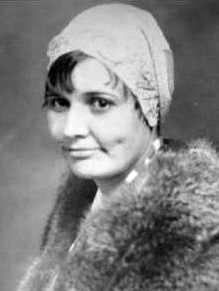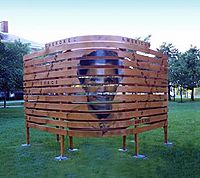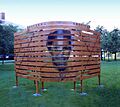Mary Golda Ross facts for kids
Quick facts for kids
Mary G. Ross
|
|
|---|---|
 |
|
| Born |
Mary Golda Ross
August 9, 1908 Park Hill, Oklahoma, United States
|
| Died | April 29, 2008 (aged 99) Los Altos, California, United States
|
| Resting place | Ross Cemetery, Park Hill, Oklahoma, United States |
| Nationality | Cherokee Nation |
| Citizenship | American |
| Education | Northeastern State Teachers' College, bachelor's degree in mathematics, 1928, and Colorado State Teachers College in Greeley, master's degree in mathematics, 1938 |
| Relatives | Great-grandfather: John Ross |
| Engineering career | |
| Employer(s) | Lockheed Corporation, 1942; joined their Advanced Development Program (Skunk Works), 1952. |
| Projects | First Native American female engineer. |
| Significant design | "Preliminary design concepts for interplanetary space travel, crewed and uncrewed earth-orbiting flights, the earliest studies of orbiting satellites for both defense and civilian purposes." |
| Awards | Silicon Valley Engineering Council’s Hall of Fame, 1992, Fellow and life member of the Society of Women Engineers, and others |
Mary Golda Ross (born August 9, 1908 – died April 29, 2008) was a very important American engineer. She was the first known Native American woman to become an engineer. She was also the first female engineer at a famous company called Lockheed.
Mary Ross was one of the first 40 engineers to work on the top-secret Skunk Works project at Lockheed Corporation. She worked there from 1942 until she retired in 1973. She is best known for her work on designing things for space. This included the Agena Rocket program. She also worked on early ideas for space travel to other planets. These ideas included flights with and without people, and studies of orbiting satellites. In 2018, she was chosen to be on the 2019 Native American $1 Coin. This coin celebrates American Indians who helped with space programs.
Contents
Mary Ross's Early Life and Education
Mary G. Ross was born in a small town called Park Hill, Oklahoma. She was the second of five children. Her parents were William Wallace Ross Jr and Mary Henrietta Moore Ross. She was the great-granddaughter of a famous leader, Cherokee Chief John Ross.
Mary was a very smart child. She went to live with her grandparents in Tahlequah. This city was the capital of the Cherokee Nation. There, she went to primary and secondary school.
When she was 16, Ross started college at Northeastern State Teachers' College in Tahlequah. She earned a bachelor's degree in mathematics in 1928. She was 20 years old at the time.
She later got her master's degree in 1938. This was from the Colorado State Teachers College in Greeley. She took "every astronomy class they had" while studying there.
Mary Ross's Engineering Career
Mary Ross taught math and science in schools in Oklahoma for nine years. This was mostly during the Great Depression.
When she was 28, she took a test to work for the Bureau of Indian Affairs (BIA). She worked in Washington, D.C. as a clerk who handled numbers. In 1937, she became an advisor for girls. This was at the Santa Fe Indian School in Santa Fe. This school was for American Indian children. She finished her master's degree in August 1938. She had taken classes in the summers while she was a teacher. She also studied astronomy and read a lot about mathematics.
In 1941, she moved to California. Her father told her to look for work there. This was after the United States joined World War II.
Working at Lockheed
Lockheed hired Mary Ross as a mathematician in 1942. She started working on how pressure affected the Lockheed P-38 Lightning airplane. The P-38 was one of the fastest planes of its time. It was the first military plane to fly faster than 640 kilometers per hour (400 mph). Mary Ross helped solve many problems with high-speed flight. She also worked on issues with how the plane's parts bent or twisted.
Mary Ross really liked working on ideas for space travel to other planets. But she later said that if she had mentioned it in 1942, people might not have believed her.
She remembered working late at night. "Often at night there were four of us working until 11 p.m.," she said. "I was the pencil pusher, doing a lot of research. My tools were a slide rule and a Friden computer."
After the war, Lockheed sent her to UCLA. There, she earned a special certificate in engineering. She studied math for modern engineering, aeronautics (the science of flight), and missile and celestial mechanics (how things move in space). It was unusual for a company to keep a woman working after the war ended. But Mary Ross continued to work for Lockheed.
Joining Skunk Works
In 1952, she joined Lockheed's Advanced Development Program. This was at the very secret Skunk Works division. There, she worked on early ideas for space travel to other planets. She also worked on flights that would orbit Earth, both with and without people. She did some of the first studies on satellites orbiting Earth. These satellites were for both defense and everyday uses.
She worked on the Agena rocket project. She also helped with early plans for missions to fly by Venus and Mars.
Many of the ideas and papers from her group are still secret. She told her college newspaper in the 1990s, "We were taking the theoretical and making it real." Mary Ross also helped write a book called the NASA Planetary Flight Handbook Vol. III. This book was about space travel to Mars and Venus.
Norbert Hill met Mary Ross when he was a director for a science and engineering group. He said, "She was just one of the guys. She was as smart as the rest of them and she held her own."
In 1958, she appeared on a TV show called What's My Line? It took the people on the show a while to guess her job. She was the person who "Designs Rocket Missiles and Satellites (Lockheed Aircraft)."
By the late 1960s, Mary Ross became a senior engineer. She worked on parts for the Polaris, Poseidon, and Trident missiles.
Mary Ross's Later Life
After she retired in 1973, Mary Ross lived in Los Altos, California. She spent her time encouraging young women and Native American youth to become engineers. She had been a member of the Society of Women Engineers since the 1950s. She also supported the American Indians in Science and Engineering Society (AISES). And she supported the Council of Energy Resource Tribes.
When she was 96, she wore her "first traditional Cherokee dress." Her niece made the green calico dress for her. She wore it for the opening of the National Museum of the American Indian in Washington, D.C. When she passed away in 2008, she left $400,000 to that museum.
Awards and Recognition for Mary Ross
Mary G. Ross received many awards for her important work:
- She was put into the Silicon Valley Engineering Council’s Hall of Fame in 1992.
- She was named Peninsula Woman of the Year by the Theta Sigma Phi group.
- She received awards from the American Indian Science and Engineering Society.
- She also received awards from the Council of Energy Resource Tribes.
- The San Francisco Examiner gave her an Award for Woman of Distinction in 1961.
- She received the Woman of Achievement Award in 1961.
- Her first two colleges gave her awards for being an outstanding former student.
- She was a Fellow and a lifelong member of the Society of Women Engineers.
- In 1992, a scholarship was created in her name by the Santa Clara Valley Section.
- Google Doodle honored her on August 9, 2018.
- Mary Ross is shown on the back of the 2019 Sacagawea Dollar coin.
Images for kids
See also
 In Spanish: Mary G. Ross para niños
In Spanish: Mary G. Ross para niños



